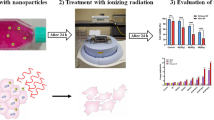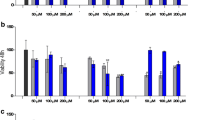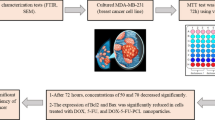Abstract
SR-2508 (etanidazole), a hypoxic radiosensitizer, has potential applications in radiotherapy. The poly(d,l-lactide-co-glycolide)(PLGA) nanoparticles containing SR-2508 were prepared by w/o/w emulsification-solvent evaporation method. The physicochemical characteristics of the nanoparticles (i.e. encapsulation efficiency, particle size distribution, morphology, in vitro release) were studied. The cellular uptake of the nanoparticles for the two human tumor cell lines: human breast carcinoma cells (MCF-7) and human carcinoma cervices cells (HeLa), was evaluated by fluorescence microscopy and transmission electronic microscopy. Cell viability was measured by the ability of single cell to form colonies in vitro. The prepared nanoparticles were spherical in shape with size between 90 nm and 190 nm. The encapsulation efficiency was 20.06%. The drug release pattern exhibited an initial burst followed by a plateau for over 24 h. The cellular uptake of nanoparticles was observed. Co-culture of MCF-7 and HeLa cells with SR-2508 loaded nanoparticles showed that released SR-2508 retained its bioactivity and effectively sensitized two hypoxic tumor cell lines to radiation. The radiosensitization of SR-2508 loaded nanoparticles was more significant than that of free drug.







Similar content being viewed by others
References
Adams GE (1981) Hypoxia-mediated drugs for radiation and chemotherapy. Cancer 48:696–709
Adams GE, Stratford IJ (1986) Hypoxia-mediated nitroheterocyclic drugs in the radio- and chemotherapy of cancer. Biochem Pharmacol 35:71–76
Astete CE, Sabliov CM (2006) Synthesis and characterization of PLGA nanoparticles. J Biomater Sci Polym Ed 17:247–289
Avgoustakis K (2004) Pegylated poly (lactide) and poly (lactide-co-glycolide) nanoparticles: preparation, properties and possible applications in drug delivery. Curr Drug Deliv 1:321–333
Bala I, Hariharan S, Kumar MN (2004) PLGA nanoparticles in drug delivery: the state of the art. Crit Rev Ther Drug Carrier Syst 21:387–422
Brigger I, Dubernet C, Couvreur P (2002) Nanoparticles in cancer therapy and diagnosis. Adv Drug Deliv Rev 54:631–651
Brown JM (1979) Evidence for actuely hypoxic cells in mouse tumour and a possible mechanism of reoxygenation. Br J Radiol 52:650–656
Brown JM (1982a) The mechanisms of cytotoxicity and chemosensitization of misonidazole and other nitromidazoles. Int J Radiat Oncol Biol Phys 8:675–682
Brown JM (1982b) Clinical perspectives for the use of new hypoxic cell sensitizers. Int J Radiat Oncol Biol Phys 8:1491–1497
Bush RS, Jenkin RDT, Allt WEC et al (1978) Definitive evidence for hypoxic cells influence in the cure in cancer therapy. Br J Cancer 37(suppl. III):302–306
Coleman CN, Wasserman TH, Urtasun RC et al (1986) Phase I trial of the hypoxic cell radiosensitizer SR-2508: the results of the five to six week drug schedule. Int J Radiat Oncol Biol Phys 12:1105–1108
Costantino L, Gandolfi F, Bossy-Nobs L et al (2006) Nanoparticulate drug carriers based on hybrid poly (d,l-lactide-co-glycolide)-dendron structures. Biomaterials 27:4635–4645
Desai MP, Labhasetwar V, Walter E et al (1997) The mechanism of uptake of biodegradable microparticles in CaCO-2 cells is size dependant. Pharm Res 14:1568–1573
Dische S (1985) Chemical sensitizers for hypoxic cell: a decade of experience in clinical radiotherapy. Radiother Oncol 3:97–115
Eschwege F, Sancho-Garnier H, Chassagne D et al (1997) Results of a European randomized trial of etanidazole combined with radiotherapy in head and neck carcinomas. Int J Radiat Oncol Biol Phys 39:273–274
Gray LH, Conger AD, Ebert M et al (1953) The concentration of oxygen dissolved in tissues at the time of irradiation as a factor in radiotherapy. Br J Radiol 26:638–648
Howes AE (1969) An estimation of changes in the proportion and absolute numbers of hypoxic cell after irradiation of transplanted C3H mouse mammary tumors. Br J Radiol 42:441–447
Konan YN, Gurney R, Allemann E (2002) Preparation and characterization of sterile and freeze-dried sub-200 nm nanoparticles. Int J Pharm 233:239–252
Kwon GS, Kataoka K (1995) Block copolymer micelles as longcirculating drug vehicles. Adv Drug Deliv Rev 16:295–309
Lawton CA, Coleman CN, Buzydlowski JW et al (1996) Results of a phase II trial of external beam radiation with etanidazole (SR-2508) for the treatment of locally advanced prostate cancer. Int J Radiat Oncol Biol Phys 36:673–680
Lee DJ, Cosmatos D, Marcial VA et al (1995) Results of an RTOG phase III trial (RRTOG 85 ± 27) comparing radiotherapy plus etanidazole with radiotherapy alone for locally advanced head and neck carcinomas. Int J Radiat Oncol Biol Phys 32:567–576
Lee TH, Wang FJ, Wang CH (2002) Double-walled microspheres for the sustained release of a highly water soluble drug: characterization and irradiation studies. J Control Release 83:437–452
Moghimi SM, Porter CJH, Muir IS et al (1991) Non-phagocytic uptake of intravenously injected microspheres in rat spleen: influence of particles size and hydrophilic coating. Biochem Biophys Res Commun 177:861–866
O’Dwyer PJ, LaCreta FP (1991) Pharmacology and clinical investigation of SR-2508 (etanidazole). In: New drugs, concepts, and results in cancer chemotherapy, pp 45–63
Panyam J, Labhasetwar V (2003) Biodegradable nanoparticles for drug and gene delivery to cells and tissue. Adv Drug Deliv Rev 55:329–347
Panyam J, Williams D, Dash A et al (2004) Solid-state solubility influences encapsulation and release of hydrophobic drugs from PLGA/PLA nanoparticles. J Pharm Sci 93:1804–1814
Riese NE, Buswell L, Noll L et al (1997) Pharacokinetic monitoring and dose modification of etanidazole in the RTOG 85–27 phase III head and neck trial. Int J Radiat Oncol Biol Phys 39:855–858
Urtasun RC, Palmer M, Kinney B et al (1998) Intervention with the hypoxic tumor cell sensitizer etanidazole in the combined modality treatment of limited stage small-cell lung cancer, a one-institution study. Int J Radiat Oncol Biol Phys 40:337–342
Wang FJ, Wang CH (2002a) Effects of fabrication conditions on the characteristics of etanidazole spray-dried microspheres. J Microencapsul 4:495–510
Wang FJ, Wang CH (2002b) Sustained release of etanidazole from spray dried microspheres prepared by non-halogenated solvents. J Control Release 81:263–280
Wang FJ, Wang CH (2003) Etanidazole-loaded microspheres fabricated by spray-drying different poly(lactide/glycolide) polymers: effects on microsphere properties. J Biomater Sci Polym Ed 14:157–183
Yin Y, Chen D, Qiao M et al (2006) Preparation and evaluation of lectin-conjugated PLGA nanoparticles for oral delivery of thymopentin. J Control Release 116:337–345
Yuan F, Leuning M, Huang SK et al (1994) Microvascular permeability and interstitial penetration of sterically stabilized (stealth) liposomes in human tumor xenograft. Cancer Res 54:3352–3356
Acknowledgement
The authors would like to thank Dr. JY Liu (Department of Radiation Medicine, Fourth Military Medical University) for technical assistance.
Author information
Authors and Affiliations
Corresponding author
Additional information
Cheng Jin and Ling Bai contributed equally to this work.
Rights and permissions
About this article
Cite this article
Jin, C., Bai, L., Wu, H. et al. Cellular uptake and radiosensitization of SR-2508 loaded PLGA nanoparticles. J Nanopart Res 10, 1045–1052 (2008). https://doi.org/10.1007/s11051-007-9336-1
Received:
Accepted:
Published:
Issue Date:
DOI: https://doi.org/10.1007/s11051-007-9336-1




